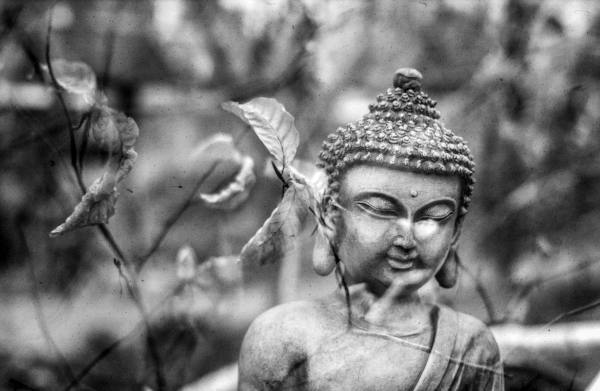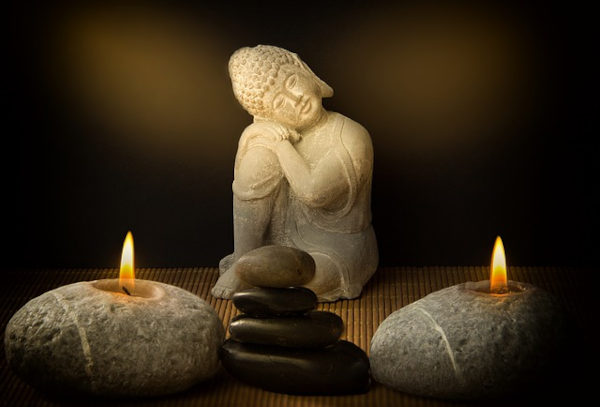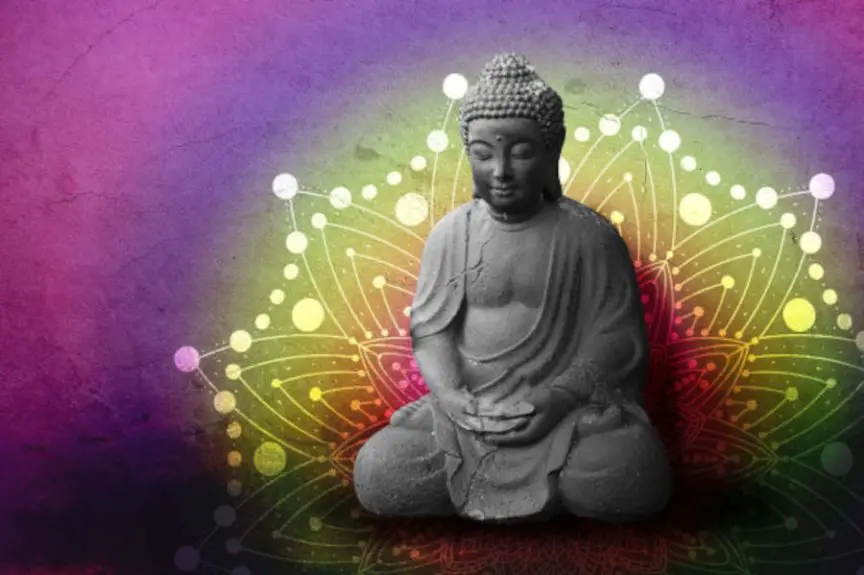Vipassana is one of the most ancient meditation techniques and is still widely practiced today all over the world, including the Western world.
If you are familiar with mindfulness meditation, Vipassana is considered one of the best techniques for practicing mindfulness. In Vipassana, we practice self-observation by focusing on our inner selves without being judgmental, and this is why Vipassana meditation is also often called “insight” meditation.
In this article, we will discuss all you need to know about Vipassana meditation, its benefits, and how to get started with this meditation technique.
What Is Vipassana Meditation?
Vipassana is one form of Buddhist and Hinduism meditation technique focused on practicing mindfulness. Unlike other forms of meditation that focus on one’s surroundings, breathing patterns, or mantra chanting, Vipassana focuses on seeing one’s inner-self, or self-reflecting.
Although there are several different variations of the Vipissana’s origins, the most common version is that Vipassana comes from the Satipatthana Sutta (The Discourse on the Establishing of Mindfulness), a scripture of Theravada Buddhism. There are, however, some that believe that Vipassana’s meditative stance has been practiced by Gautama Buddha himself.
Vipassana meditation was popularized in the modern world by S.N. Goenka, a Myanmar-born Indian who learned Vipassana from Sayagyi U Ba Khin, a renowned Vipassana teacher who was the first to teach Westerners. As a result, Vipassana has gained widespread popularity all over the world since 1969.
Vipassana, as discussed, is also called “insight” meditation, and is a method of meditation where you’ll indulge yourself in a deep and thorough self-observation. Proper Vipassana meditation practice can improve the interconnection between mind, body, and soul: by observing your own inner mind, Vipassana mediation trains you to acknowledge your own nature, be content, and be joyful with yourself.
Related reading: Guide to Different Types of Meditation Practices – Opens in new tab
Benefits of Vipassana Meditation
Vipassana helps us discover how we can fulfill our lives without relying on external factors, and below we’ll discuss some examples of how Vipassana meditation can benefit its practitioners:
1.Increasing Awareness
Vipassana can help you not only to improve your awareness of yourself but towards anything in your life, both positive and negative. In turn, this can allow yourself to understand how your body and mind work and help regulate your emotion. In this research, it is suggested that meditative activities have increased the practitioner’s sensitivity and awareness, which leads to overall brain reactivity.
2.Calming your mind
Practicing Vipassana meditation can help reduce your negative emotion and thoughts, and as your mind is solidified with positive and constructive thoughts, you’ll get a clearer and calmer state of mind. In this research, Vipassana meditation practitioners have shown a significant decrease in heart rate and calmer emotions during observation.

3.Improved equanimity
Equanimity is the state of having a balanced mind, as well as composure and stability of our mind, body, and soul. Having equanimity means you’ll not easily panic and won’t try to always be in control: you’ll face every situation with clearer thinking and quicker response. Meditation has been shown to activate our brain functions, allowing our brain and body to respond with equanimity each time a new problem comes in your way.
4.Mental wellbeing
It’s no secret that mental health is a major issue in this modern age, and PTSD (Post-Traumatic Stress Disorder) is one mental health issue that troubles many people. However, according to this research, Vipassana meditation is effective in reducing symptoms of PTSD, even in people suffering from severe PTSD. In another research that tracks the brain function (prefrontal and anterior cingulate cortex) during Vipassana meditation, meditation is shown to be very effective in relieving symptoms of mental illnesses and can calm the mind better than alcohol consumption.
Different Types of Vipassana Meditation
Although there are various different variations to Vipassana meditation, generally we can divide them into four major groups:

1.Kayanupassana (Continuous Observation of the Body)
This type of Vipassana meditation focuses on one’s body to develop it as a temple. In this technique, we focus on observing the body as we meditate, being aware of our breathing, and adjusting our posture and abdomen appropriately. Achieving mastery in Kayanupassana can help us improve our awareness of the impermanence of various things, allowing us to be enlightened to achieve inner peace.
2. Vedananupassana (Continuous Observation of Feelings)
This Vipassana meditation technique focuses on observing, reflecting, and understanding our continuous flux of feelings. Understanding the energy that flows from our feelings (positive, negative, neutral) will also help strengthen our mind and body. Also, by observing how each feeling is conceived, we can more easily regulate and reduce negative feelings like anger, greed, delusional thoughts, envy, and so on.
3. Cittanupassana (Continuous Observation of the Mind)
This type of Vipassana meditation is based on observing your own mind continuously. By observing the changes in our minds, we can enhance our depth of thinking while exploring various different perspectives. Mastering Cittanupassana can help free our mind from harmful thoughts, and the more we practice this type of meditation, the better we’ll be able to avoid toxic thoughts that can make your mind, body, and soul suffer.
4. Dhammanupassana (Continuous Observation of Mental Processes)
Last but not least, the Dhammanupassana is by far, the most abstract out of the four, and focuses on one’s mental processes rather than thoughts or feelings. By being mindful of mental processing, you can more easily control your state of mind when experiencing negative situations. By observing and recollecting how your mind processes each situation, you can better regulate your mind and neutralize bad thoughts inside your mind.

How To Do Vipassana Meditation
Preparing your Vipassana meditation session
You’d want to prepare a specific room or location where you can comfortably achieve a deep focus state. You’d want a place that is spacious enough for you to be comfortable and as quiet as possible.
You’d also want to prepare a cushion (if you plan for a long meditation), and if you are planning to use a background music/audio guide, you can prepare the necessary equipment. You can also use aromatherapy to help create the right atmosphere for you.
In short, prepare a place where you can relax and achieve focus. You can also meditate in an open-air area, for example under a tree.
Sit and Get Into Your Meditative Form
Get into your meditative position: sit quietly with your legs crossed. Maintain a straight posture, not only so that you can achieve focus faster, but an arched sitting position can bring pain if you maintain this position for a long time. Your effort to remain upright during the meditation can in fact help you achieve focus and can enhance your meditation practice.
For those with back issues, you can sit in a chair or use more comfortable sitting positions. However, the basic principle is to sit with your back straight but not too stiff, your back should make a 90-degree angle to the ground.
Related reading: How to Find a Comfortable Meditation Position – Opens in new tab.
Choose The Right Type of Meditation
Above, we have discussed the different types of Vipassana meditation available, and you can choose the right meditation type based on your objective. You can choose to combine different types and even choose to reflect on everything about yourself. However, it’s better to focus on one thing at a time to get clearer insights and better results.
Maintain Your Breathing
Close your eyes and focus your attention on your abdomen, just below your belly. Breathe normally and don’t force your breathing: maintain a natural breathing pattern and speed. Focus on any sensation that comes as you breathe in and your abdomen rises, and as you breathe out and the abdomen falls. Observe any sensation.
By breathing naturally using your nose and channeling the air towards your abdomen, it will produce inner energy to help ease your mind. This way, you can achieve the deep focus faster.
Develop Your Attention
As you keep meditating, your mind can be easily drifted. Aim to sharpen your mind by making sure that your mind is focused on the entirety of each mental process. Be aware of all sensations while maintaining steady attention throughout the meditation session.
It’s important to be aware of your breathing and the sensations as a complete process instead of breaking them down into different elements (i.e. breathing in vs breathing out). Focus on the whole process as a whole, and do not be over-focused. Be observant, but don’t specifically look for anything.
To help in being more observant, you can mention the sensation silently in your mind. When any sensations arise, focus direct awareness on them and don’t avoid them.
Decide On a Duration
Setting up duration is also an important part of Vipassana meditation. For a beginner, a 5-10 minutes session is a good start, and as you get more comfortable you can increase the duration up to 30 minutes or even 1 hour and more.
Finishing Your Vipassana Meditation
After the duration ends, control your breathing as you slowly open your eyes. Spend several minutes of cooling down and you can stretch your body (i.e. light Yoga session) before you assume other activities.
Do you want to learn more about Meditation? Check out our recommendations at “Meditation Bookshelf” and many free resources at our “Free MeditationLibrary“ – Opens in new tab
Stay in Touch
 Join our newsletter by using the forms on this website or click here!
Join our newsletter by using the forms on this website or click here! Follow us on Google News
Follow us on Google News Follow us on Facebook
Follow us on Facebook
Featured image by Alexandra Koch from Pixabay






